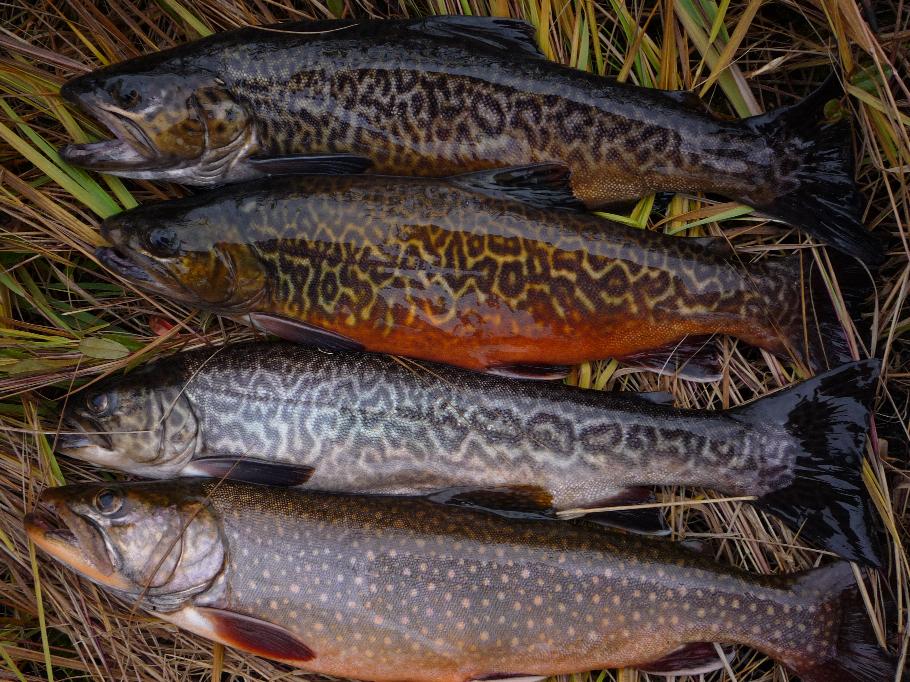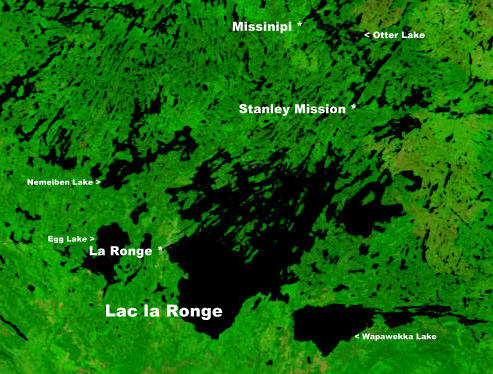La Ronge, Saskatchewan on:
[Wikipedia]
[Google]
[Amazon]
La Ronge is a northern town in the
 With the extension of Highway 2 from Prince Albert in 1947, La Ronge became a major tourist
With the extension of Highway 2 from Prince Albert in 1947, La Ronge became a major tourist
 La Ronge is surrounded by several
La Ronge is surrounded by several
 The community is also home to the La Ronge Ice Wolves
The community is also home to the La Ronge Ice Wolves
Churchill Community High School
an
/ Senator Myles Venne High School
Elementary schools in La Ronge and Air Ronge include Pre-cam Community School, Gordon Denny Community School, and Bells Point Elementary School. Northlands College maintains its main campus in La Ronge and took over the Nortep / Norpac program after the Saskatchewan provincial government cut funding to the program in March 2017.
boreal forest
Taiga or tayga ( ; , ), also known as boreal forest or snow forest, is a biome characterized by pinophyta, coniferous forests consisting mostly of pines, spruces, and larches. The taiga, or boreal forest, is the world's largest land biome. I ...
of Saskatchewan
Saskatchewan is a Provinces and territories of Canada, province in Western Canada. It is bordered on the west by Alberta, on the north by the Northwest Territories, on the east by Manitoba, to the northeast by Nunavut, and to the south by the ...
, Canada. The town is also the namesake of the larger La Ronge
La Ronge is a List of municipalities in Saskatchewan, northern town in the boreal forest of Canada, boreal forest of Saskatchewan, Canada. The town is also the namesake of the larger #Population centre, La Ronge population centre, the largest ...
population centre, the largest in northern Saskatchewan, comprising the Northern Village of Air Ronge
Air Ronge is a northern village in Northern Saskatchewan, Canada, 235 km north of Prince Albert. It lies on the western shore of Lac la Ronge, and is 3 km south of La Ronge and Lac La Ronge Provincial Park. According to 2006's census, ...
, and the Kitsakie 156B and Lac La Ronge 156 reserves of the Lac La Ronge First Nation.
The town is located approximately north of Prince Albert
Prince Albert most commonly refers to:
*Prince Albert of Saxe-Coburg and Gotha (1819–1861), consort of Queen Victoria
*Albert II, Prince of Monaco (born 1958), present head of state of Monaco
Prince Albert may also refer to:
Royalty
* Alb ...
and lies on the western shore of Lac la Ronge, is adjacent to Lac La Ronge Provincial Park, and is on the edge of the Canadian Shield
The Canadian Shield ( ), also called the Laurentian Shield or the Laurentian Plateau, is a geologic shield, a large area of exposed Precambrian igneous and high-grade metamorphic rocks. It forms the North American Craton (or Laurentia), th ...
.
History
The name "La Ronge" comes from the lake itself, although the actual origin of the name is uncertain. The French verb ''ronger'' translates as "to gnaw", with at least one explanation theorising that 17th- and 18th-century French fur traders referred to the lake as ''la ronge'' (literally, ''the chewed'') due to the abundantbeaver
Beavers (genus ''Castor'') are large, semiaquatic rodents of the Northern Hemisphere. There are two existing species: the North American beaver (''Castor canadensis'') and the Eurasian beaver (''C. fiber''). Beavers are the second-large ...
population along the lake’s shoreline. Undoubtedly, many of the trees along the water’s edge would have been visibly chewed, or completely gnawed to the ground and taken away by the rodents
Rodents (from Latin , 'to gnaw') are mammals of the order Rodentia ( ), which are characterized by a single pair of continuously growing incisors in each of the upper and lower jaws. About 40% of all mammal species are rodents. They are n ...
for their dam construction.
In 1782, Swiss born fur trader Jean-Étienne Waddens had a fur trade post on Lac La Ronge. In March 1782, Waddens was fatally wounded in a quarrel with his associate Peter Pond
Peter Pond (January 18, 1739 – 1807) was an American explorer, cartographer, merchant and soldier who was a founding member of the North West Company and the Beaver Club. Though he was born and died in Milford, Connecticut, most of his li ...
.
La Ronge began in 1904 as a fur trading post
A trading post, trading station, or trading house, also known as a factory in European and colonial contexts, is an establishment or settlement where goods and services could be traded.
Typically a trading post allows people from one geogr ...
and meeting place, but with the decline of hunting and the fur market, La Ronge has diversified into other areas. Many of the Dene
The Dene people () are an Indigenous group of First Nations who inhabit the northern boreal, subarctic and Arctic regions of Canada. The Dene speak Northern Athabaskan languages and it is the common Athabaskan word for "people". The term ...
, Cree
The Cree, or nehinaw (, ), are a Indigenous peoples of the Americas, North American Indigenous people, numbering more than 350,000 in Canada, where they form one of the country's largest First Nations in Canada, First Nations. They live prim ...
, and white trappers used La Ronge as their central service point. It incorporated as a northern village on 3 May 1905.
 With the extension of Highway 2 from Prince Albert in 1947, La Ronge became a major tourist
With the extension of Highway 2 from Prince Albert in 1947, La Ronge became a major tourist fishing
Fishing is the activity of trying to catch fish. Fish are often caught as wildlife from the natural environment (Freshwater ecosystem, freshwater or Marine ecosystem, marine), but may also be caught from Fish stocking, stocked Body of water, ...
area. The highway
A highway is any public or private road or other public way on land. It includes not just major roads, but also other public roads and rights of way. In the United States, it is also used as an equivalent term to controlled-access highway, or ...
between La Ronge and Prince Albert expanded the community further in the 1970s after it was paved.
In the early 1950s and 1960s, the mineral
In geology and mineralogy, a mineral or mineral species is, broadly speaking, a solid substance with a fairly well-defined chemical composition and a specific crystal structure that occurs naturally in pure form.John P. Rafferty, ed. (2011): Mi ...
resources in the La Ronge area began to be explored and developed.
La Ronge's status changed from northern village to industrial town in 1965 and then to town on 1 November 1976 before finally becoming a northern town on 1 October 1983.
Wildfire evacuations
In May 1999, the community of La Ronge was evacuated after a fire burned through the far north of the town. Thewildfire
A wildfire, forest fire, or a bushfire is an unplanned and uncontrolled fire in an area of Combustibility and flammability, combustible vegetation. Depending on the type of vegetation present, a wildfire may be more specifically identified as a ...
burned multiple houses before conditions pushed the fire away from the town and crews were able to extinguish it.
Once again in July 2015, La Ronge was threatened by dangerous forest fires that combined forcing approximately 7,000 people to evacuate from their homes. Many cabins and homes were burnt. The fire came within 2 km of La Ronge and burned completely around the La Ronge Airport making it difficult to fight the fire from air with smokey conditions and unreliable weather making the fight against the fires very difficult. In total there were over a hundred fires burning in Northern Saskatchewan at once which forced over 13,000 residents to flee their homes, resulting in the province's largest evacuation ever. The fires were caused by low precipitation in the winter and summer months and also high temperatures.
Geography
 La Ronge is surrounded by several
La Ronge is surrounded by several First Nations
First nations are indigenous settlers or bands.
First Nations, first nations, or first peoples may also refer to:
Indigenous groups
*List of Indigenous peoples
*First Nations in Canada, Indigenous peoples of Canada who are neither Inuit nor Mé ...
reserves, with the Northern Village of Air Ronge located just south of the community on Highway 2. With access to all other points north, east and west, and transportation linkage to the south, La Ronge is also the northern hub for the Saskatchewan provincial government.
Climate
According to the Köppen–Geiger and Trewartha climate classification systems, La Ronge experiences a borderline (warm-summer) humid continental climate (Köppen ''Dfb''; Trewartha ''Dc'')—prior to the 1991–2020 normals, it experienced acontinental subarctic climate
The subarctic climate (also called subpolar climate, or boreal climate) is a continental climate with long, cold (often very cold) winters, and short, warm to cool summers. It is found on large landmasses, often away from the moderating effects of ...
(Köppen ''Dfc''; Trewartha ''Ec''). Winters are long, dry and very cold while summer is short, warm and wetter. Precipitation is fairly low, with an annual average of . The highest temperature ever recorded in La Ronge was on 23 August 1929. The coldest temperature ever recorded was on 15 February 1936.
Demographics
In the 2021 Census of Population conducted byStatistics Canada
Statistics Canada (StatCan; ), formed in 1971, is the agency of the Government of Canada commissioned with producing statistics to help better understand Canada, its population, resources, economy, society, and culture. It is headquartered in ...
, La Ronge had a population of living in of its total private dwellings, a change of from its 2016 population of . With a land area of , it had a population density of in 2021.
Population centre
The La Ronge population centre, the fourteenth largest population centre in the province, comprises four adjoiningcensus subdivision
The census geographic units of Canada are the census subdivisions defined and used by Canada's federal government statistics bureau Statistics Canada to conduct the country's quinquennial census. These areas exist solely for the purposes of st ...
s including the Northern Town of La Ronge, the Northern Village of Air Ronge and the Kitsakie 156B and Lac La Ronge 156 Indian reserves of the Lac La Ronge First Nation.
In the 2016 Census, Statistics Canada reported that the La Ronge population centre had a population of 5,671 living in 1,704 of its 1,927 total dwellings, a +6.6% change from its 2011 population of 5,318. With a land area of , it had a population density of in 2016.
The following is a population breakdown of the La Ronge population centre by census subdivision.
Economy
Several mining companies, government agencies, and airlines now keep offices in La Ronge, and the local Chamber of Commerce has many other retail and service businesses amongst its members. La Ronge Wild Rice Corporation processes freshly harvested wild rice (in August to October) from Northern Saskatchewan farmers. Tourism also brings in many of people to the La Ronge area. In the summer time, many people visit the Lac La Ronge Provincial Park which is Saskatchewan's largest Provincial Park.Sports
 The community is also home to the La Ronge Ice Wolves
The community is also home to the La Ronge Ice Wolves ice hockey
Ice hockey (or simply hockey in North America) is a team sport played on ice skates, usually on an Ice rink, ice skating rink with Ice hockey rink, lines and markings specific to the sport. It belongs to a family of sports called hockey. Tw ...
team of the Saskatchewan Junior Hockey League
The Saskatchewan Junior Hockey League is a Junior 'A' ice hockey league operating in the Canadian province of Saskatchewan and one of nine member leagues of the Canadian Junior Hockey League.
Open to North American-born players 20 years o ...
, La Ronge minor hockey association and the La Ronge Crushers men's hockey league and the La Ronge women's hockey league. La Ronge also has a minor baseball program with many teams and age groups.
La Ronge is home to an 8 team Ladies Slopitch League - JRMCC Ladies Slopitch ( slow-pitch softball). The Churchill Community High School and the Senator Myles Venne High School both have many sports programs and partake in the Saskatchewan High School Athletic Association. There are many other sports available in the community including volleyball
Volleyball is a team sport in which two teams of six players are separated by a net. Each team tries to score points by grounding a ball on the other team's court under organized rules. It has been a part of the official program of the Summ ...
, broomball
Broomball is a both a recreational and organized competitive winter sport, winter and ball sport played on ice or snow. It is played either indoors or outdoors, depending on the climate and location. It is most popularly played in Canada and the ...
, curling
Curling is a sport in which players slide #Curling stone, stones on a sheet of ice toward a target area that is segmented into four concentric circles. It is related to bowls, boules, and shuffleboard. Two teams, each with four players, take t ...
and a women's hockey program.
Government
In 2009, La Ronge elected 21-year-old councillor Thomas Sierzycki as its mayor. This established La Ronge as having one of the youngest mayors in Canada. Sierzycki stayed in office for two terms up until October 2016 when he decided not to run for a third term after a failed bid to land himself a seat as a Saskatchewan MLA with the Saskatchewan Party in the April 2016 election.Education
There are two high schools and three elementary schools in La Ronge and Air Ronge. High schools includChurchill Community High School
an
/ Senator Myles Venne High School
Elementary schools in La Ronge and Air Ronge include Pre-cam Community School, Gordon Denny Community School, and Bells Point Elementary School. Northlands College maintains its main campus in La Ronge and took over the Nortep / Norpac program after the Saskatchewan provincial government cut funding to the program in March 2017.
Transportation
La Ronge is connected to southern Saskatchewan by Highway 2, which continues north as Highway 102. La Ronge is served by the La Ronge (Barber Field) Airport and the La Ronge Water Aerodrome.Notable people
* Danis Goulet, Cree-Métis film director and screenwriterCam Fuller, "'Wapawekka' in festival". ''Regina Leader-Post
The ''Regina Leader-Post'' is a broadsheet newspaper published in Regina, Saskatchewan, owned by Postmedia Network.
Founding
The newspaper was first published as ''The Leader'' in 1883 by Nicholas Flood Davin, soon after Edgar Dewdney, Lieutenan ...
'', 18 December 2010.
See also
*List of towns in Saskatchewan
A town is a type of incorporated urban municipality in the Canadian province of Saskatchewan. A resort village or a village
A village is a human settlement or community, larger than a hamlet but smaller than a town with a populati ...
* List of communities in Saskatchewan
Communities in the province of Saskatchewan, Canada, include Incorporation (municipal government), incorporated municipalities, Unincorporated area#Canada, unincorporated communities and First Nations in Canada, First Nations communities.
Types ...
* List of Indian reserves in Saskatchewan
The following is the List of Indian reserves in Saskatchewan, Canada. There are over 700 Indian reserves in Saskatchewan.
A
B
C
D
E
F
G
H
I
J
K
L
M
N
O
P
R
S
T
W
Y ...
References
External links
* {{Authority control Division No. 18, Saskatchewan Northern towns in Saskatchewan